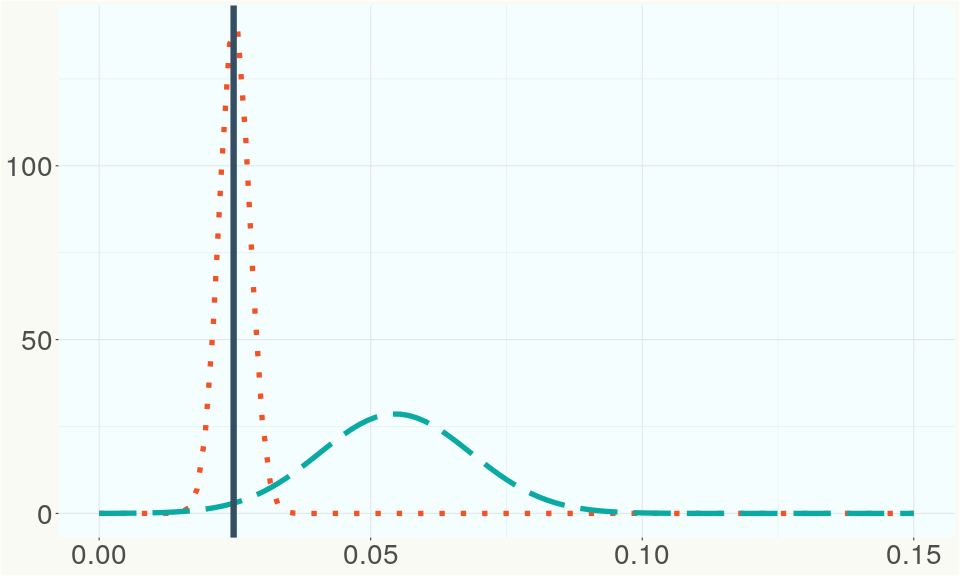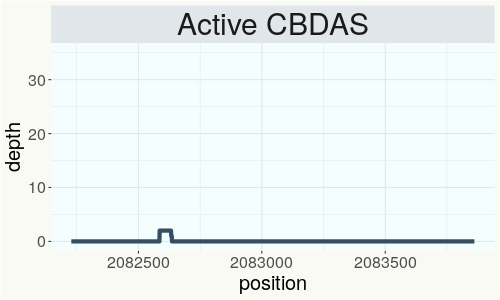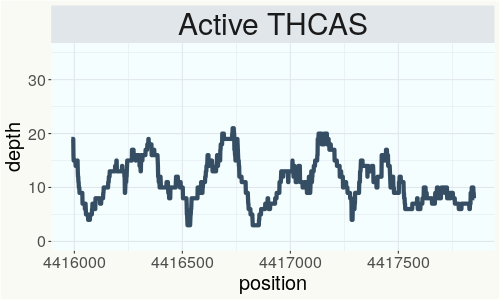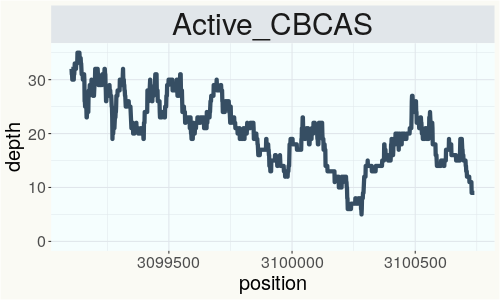DB Dried
RSP 13119
Grower: Zamir Punja
General Information
- Sample Name
- DB Dried-20240416
- Accession Date
- April 24, 2024
- Reported Plant Sex
- Female
- Report Type
- Whole-Genome Sequencing
- Microbiome
- Krona Plot
- Fungal Microbiome
- Krona Plot
- Bacterial Microbiome
- Krona Plot
- Viral Microbiome
- Krona Plot
The strain rarity visualization shows how distant the strain is from the other cultivars in the Kannapedia database. The y-axis represents genetic distance, getting farther as you go up. The width of the visualization at any position along the y-axis shows how many strains there are in the database at that genetic distance. So, a common strain will have a more bottom-heavy shape, while uncommon and rare cultivars will have a visualization that is generally shifted towards the top.
Chemical Information
Cannabinoid and terpenoid information provided by the grower.
Cannabinoids
No information provided.
Terpenoids
No information provided.
Genetic Information
- Plant Type
- Type I
File Downloads
The bell curve in the heterozygosity visualization shows the distribution of heterozygosity levels for cannabis cultivars in the Kannapedia database. The green line shows where this particular strain fits within the distribution. Heterozygosity is associated with heterosis (aka hybrid vigor) but also leads to the production of more variable offspring. When plants have two genetically different parents, heterozygosity levels will be higher than if it has been inbred or backcrossed repeatedly.
The ratio of reads mapped to Y-contigs to reads mapped to the whole Cannabis genome (Y-ratios) has been demonstrated to be strongly correlated with plant sex typing. This plot shows the distribution of Y-ratios for all samples in our database which were sequenced with the same method (panel or WGS) as this sample and where this sample falls in the distribution.

This chart represents the Illumina sequence coverage over the Bt/Bd allele. These are the three regions in the cannabis genome that impact THCA, CBDA, CBGA production. Coverage over the Active CBDAS gene is highly correlated with Type II and Type III plants as described by Etienne de Meijer. Coverage over the THCA gene is highly correlated with Type I and Type II plants but is anti-correlated with Type III plants. Type I plants require coverage over the inactive CBDA loci and no coverage over the Active CBDA gene. Lack of coverage over the Active CBDA and Active THCA allele are presumed to be Type IV plants (CBGA dominant). While deletions of entire THCAS and CBDAS genes are the most common Bt:Bd alleles observed, it is possible to have plants with these genes where functional expression of the enzyme is disrupted by deactivating point mutations (Kojoma et al. 2006).



This chart represents the Illumina sequence coverage over the CBCA synthase gene.

Variants (THCAS, CBDAS, and CBCAS)
No variants to report
Variants (Select Genes of Interest)
| EMF1-2 | c.710A>C | p.His237Pro | missense variant | moderate | contig885 | 810 | A/C | |
| PHL-2 | c.1057A>G | p.Arg353Gly | missense variant | moderate | contig2621 | 340335 | A/G | |
| PHL-2 | c.1096G>A | p.Ala366Thr | missense variant | moderate | contig2621 | 340374 | G/A | |
| PHL-2 | c.2933G>T | p.Arg978Leu | missense variant | moderate | contig2621 | 342976 | G/T | |
| DXR-2 | c.1319T>C | p.Ile440Thr | missense variant | moderate | contig380 | 285250 | A/G |
|
| DXR-2 | c.431C>G | p.Ala144Gly | missense variant | moderate | contig380 | 287760 | G/C | |
| aPT4 | c.16G>A | p.Val6Ile | missense variant | moderate | contig121 | 2828672 | G/A |
|
| aPT4 |
c.235_236del |
p.Val79fs | frameshift variant | high | contig121 | 2829030 | ATG/A |
|
| aPT4 | c.238delT | p.Ser80fs | frameshift variant | high | contig121 | 2829034 | AT/A |
|
| aPT4 | c.302A>G | p.Asn101Ser | missense variant | moderate | contig121 | 2829099 | A/G |
|
| aPT1 | c.406A>G | p.Ile136Val | missense variant | moderate | contig121 | 2839605 | A/G | |
| PIE1-2 | c.6773T>C | p.Leu2258Ser | missense variant | moderate | contig1460 | 1184314 | A/G | |
| PIE1-2 | c.710C>T | p.Pro237Leu | missense variant | moderate | contig1460 | 1193804 | G/A | |
| PIE1-2 | c.706T>C | p.Tyr236His | missense variant | moderate | contig1460 | 1193808 | A/G | |
| FT | c.240C>G | p.Asn80Lys | missense variant | moderate | contig1561 | 3124664 | C/G |
|
| FLD | c.2929T>C | p.Phe977Leu | missense variant | moderate | contig1450 | 2044103 | A/G | |
| FLD | c.2686G>A | p.Ala896Thr | missense variant | moderate | contig1450 | 2044848 | C/T | |
| FLD | c.125G>A | p.Ser42Asn | missense variant | moderate | contig1450 | 2047909 | C/T | |
| AAE1-3 | c.659G>A | p.Arg220Gln | missense variant | moderate | contig976 | 1083195 | C/T |
|
| AAE1-3 | c.634G>C | p.Gly212Arg | missense variant | moderate | contig976 | 1083220 | C/G |
|
| AAE1-3 | c.199A>G | p.Asn67Asp | missense variant | moderate | contig976 | 1083876 | T/C |
|
| AAE1-3 | c.188A>G | p.Asn63Ser | missense variant | moderate | contig976 | 1083887 | T/C |
|
| PIE1-1 | c.1222C>G | p.Gln408Glu | missense variant | moderate | contig1225 | 2281482 | C/G | |
| PIE1-1 | c.6725C>T | p.Ala2242Val | missense variant | moderate | contig1225 | 2289290 | C/T |
Nearest genetic relatives (All Samples)
- 0.052 DB (RSP13083)
- 0.075 DB (RSP12930)
- 0.109 DB (RSP12936)
- 0.173 Black Triangle (RSP11638)
- 0.186 GG 4 (RSP11461)
- 0.187 501st OG (RSP11241)
- 0.193 RKM-2018-032 (RSP11124)
- 0.194 RKM-2018-021 (RSP11113)
- 0.196 RKM-2018-017 (RSP11109)
- 0.198 GG4 (RSP12096)
- 0.200 Lemon OG Haze (RSP11977)
- 0.202 SHERBERT (RSP11355)
- 0.211 Tahoe OG (RSP11189)
- 0.216 RKM-2018-008 (RSP11099)
- 0.217 JL Cross 10 (RSP11511)
- 0.217 RKM-2018-012 (RSP11103)
- 0.218 PK (RSP12932)
- 0.218 GG4 (RSP11978)
- 0.218 T20 Dried (RSP13125)
- 0.219 Mother s Milk No 31 (RSP11623)
Most genetically distant strains (All Samples)
- 0.462 Jamaican Lion (RSP12916)
- 0.459 Jamaican Lion (RSP12913)
- 0.458 Unknown- Cherry Wine - 001 (RSP11268)
- 0.457 Cherry Blossom (RSP11317)
- 0.457 Unknown- Cherry Wine - 003 (RSP11270)
- 0.453 Jamaican Lion (RSP12917)
- 0.452 JL yellow (RSP11075)
- 0.451 Unknown- Cherry Wine - 004 (RSP11271)
- 0.444 Jamaican Lion (RSP12915)
- 0.441 Tiger Tail 30 (RSP11484)
- 0.440 Punta Roja (RSP12923)
- 0.437 Cherry Blossom (RSP11298)
- 0.436 Cherry Blossom (RSP11311)
- 0.435 Tanao Sri 46 (RSP11486)
- 0.435 80E (RSP11213)
- 0.431 Squirrel Tail 81 (RSP11622)
- 0.431 IUP2 (SRR14708257)
- 0.430 IUP3 (SRR14708256)
- 0.429 Unknown- Cherry Wine - 002 (RSP11269)
- 0.429 JL 3rd Gen Mother (RSP11214)
Nearest genetic relative in Phylos dataset
- Overlapping SNPs:
- 88
- Concordance:
- 59
Nearest genetic relative in Lynch dataset
- Overlapping SNPs:
- 3
- Concordance:
- 3
Blockchain Registration Information
- Transaction ID
-
a823d9fbce953b52
4a3e2ff2da29dfa8 6aa536179e5441b8 89d00d08c98eb484 - Stamping Certificate
- Download PDF (39.5 KB)
- SHASUM Hash
-
86b3581622cdb965e9b76191eb24e4d1 d6c691c12a9a7b99 24cd67f199801b54